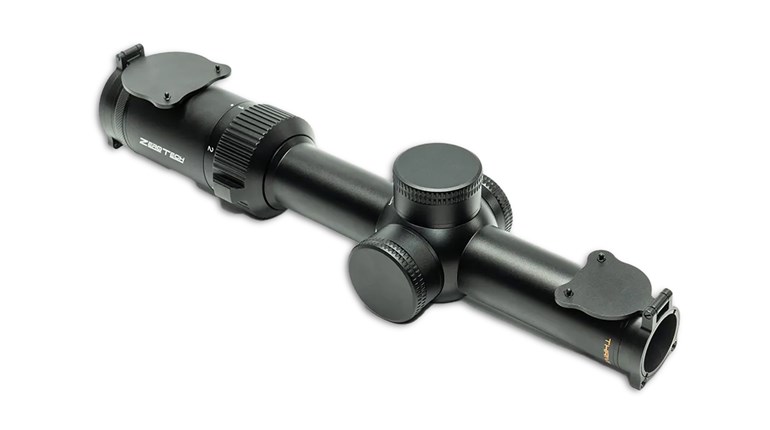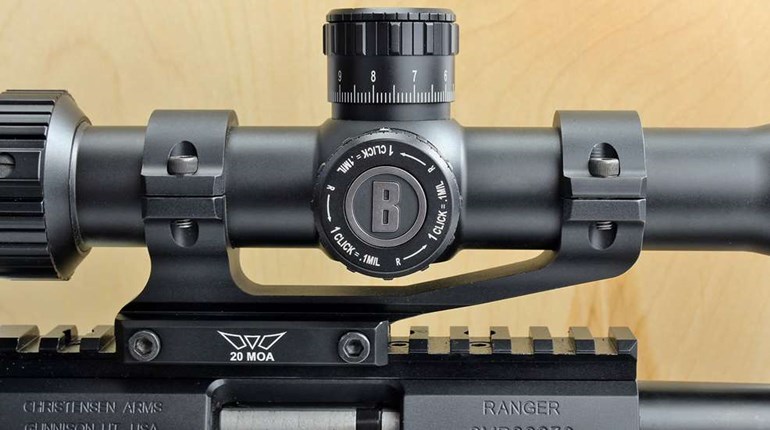
Low-power, variable optics like the 1-10X EOTech Vudu (above) offer a one-size-fits-most solution for a variety of rifles and carbines.
Much has changed since my last dive into low-power, variable optics, or LPVOs. Considering the popularity of these riflescopes—and the fact I’m in the market for a replacement—it’s a good time to examine how things have progressed in recent years. The main changes are reduced weights and increased magnifications. I’m most interested in the highest-power models with first-focal-plane (FFP), mil-based reticles that feature ample elevation and wind-hold markings below center. There are many more second-focal-plane (SFP) LPVOs, as well as other good reticle designs (such as MOA) and bullet-drop-compensating (BDC) configurations. So, you’ll have a much larger pool of options if you’re looking for these styles.
While there are several good riflescopes with 2X magnification on the low end, I prefer to stick with the LPVO’s 1X bottom level for the fastest target acquisition at closer ranges. On the upper end, I’m relearning that, with the right reticle, I can do everything I need to do with 10X out to 1,000 yards. Fortunately, several scope makers are now in the 1-10X game.
I’ve been impressed by the handful of Vortex Razor HD Gen III 1-10x24 mm scopes I’ve mounted and tested on customers’ rifles over the past couple years. Quality is excellent, the 21.5-ounce weight is reasonable and its features are solid. Likewise, previous experiences with March Scopes’ products have me scrutinizing its sub-20-ounce, dual-focal-plane 1-10x24 mm Shorty line. Unfortunately, both companies’ offerings are off-the-shelf priced in the mid-$2,000 range. Also, March Scopes’ Shorty models require the company’s Unimount, which has a 30 mm ring for the scope body and a 33 mm ring for the objective.
At the other end of the cost spectrum, SIG Sauer’s Tango MSR 1-10x28 mm scope is the least expensive option I’ve laid hands on. Street priced somewhere between $600 and $700 and weighing 21.9 ounces, this scope did well for me during a 100-yard range test. Unfortunately, the MSR BDC-10 reticle isn’t set up for mil (or MOA) holds for elevation and windage corrections. A representative from SIG Optics told me there are no plans to add more reticle choices for this scope, which seems a bit shortsighted. While the Tango MSR’s glass clarity was not on par with higher cost bracket scopes, that’s a tradeoff one has to accept in this price range.
EOTech’s Vudu 1-10x28 mm FFP riflescope comes very close to hitting the mark for me. Coming in at 21.3 ounces and street priced in the $1,500 to $1,600 range, this scope’s LE-5 and SR-5 reticle options provide 12 mils of well-marked elevation and wind holds below center. The Vudu is packed with other nice features, including locking elevation and capped windage knobs as well as a push-button rheostat. My only hang-up is that the entire eyepiece rotates when zooming, as opposed to having an independent zoom ring in front of the eyepiece. That’s good for ease and speed of zooming, but bad for flip-open scope caps, most of which will have to be repositioned when changing from lowest to highest magnification. My current 1-8X LPVO uses this same, aggravating setup, which I’d hoped to avoid on my next scope.
Atibal’s X 1-10x30 mm FFP riflescope is reasonably priced, weighs 21.1 ounces and has earned good reviews. However, I haven’t seen one up close. This optic also has a 35 mm main tube, which limits ring and mount choices. According to a company rep who participates in forums, some of Atibal’s 1-10X lenses come from a reputable Japanese maker, while other lenses come from China. It’s commendable that Atibal doesn’t hide this fact and that the company also encourages customer input. On the difficulty scale, sweet-talking component source and origin information out of a riflescope maker falls between bathing a bobcat and pulling a bad molar from a mule.
There are other companies making 1-10X FFP optics, but they’re priced so low that overall quality is a concern for me. Inexpensive, feature-packed riflescopes are oftentimes fully sourced from and manufactured in countries not known for high-quality optics. When it comes to the sighting system that will guide my go-to rifle, I’ll save up for quality I can count on, rather than risk a too-good-to-be-true deal.
With a dwindling list of possibles, I decided to see if anyone has made the 1-12X FFP leap. It turns out that Atibal has with its Hybrid 1-12x32 mm. The company classifies this as a Medium Power Variable Optic (MPVO), which seems appropriate for this magnification range. The Hybrid is only 3 ounces heavier than its 1-10X version and uses the same 35 mm main tube. I could trade the limited mounting solutions for the extra magnification, but Atibal’s mil-based reticles have minimal mil graduations, plus a whole bunch of unnumbered windage dots to get lost among when making fast transitions between targets at different ranges. Atibal also offers a “Plumb” reticle, which features quick ranging and aiming references, in addition to vertical and horizontal mil scales. Unfortunately, it lacks any mil numbering below center reticle or among the windage-hold dots.
In my April column, I joked about being ready to buy a new rifle, only to be wowed away by something newer and flashier at the last minute. That’s exactly what’s happened with my LPVO search. I began by looking at 1-10X scopes, but now I’m wondering if I should wait to see if other companies decide to cross the 1-12X threshold. I shouldn’t complain. We’ve come a long way in the 20 years since our only option for a battlefield-quality, FFP LPVO was a 1-4x20 mm scope that only Uncle Sam could afford. I was happy to carry one of those and used it heavily while in uniform, but it was less than ideal when needing to push out to 600 meters and beyond.
Although I haven’t settled on the right scope for my “bestie” rifle yet, I’m getting there—a tenth-mil click at a time.



































